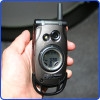Review: Palm Treo 750
The Treo 750 runs a slightly updated version of Windows Mobile 5 Pocket PC Phone Edition. We previously reviewed this operating system on the T-Mobile MDA and other phones. Much of what follows is similar to previous Pocket PC Phone reviews, however we have made changes where either Palm or Microsoft has updated the software.
For Windows Mobile 5, Microsoft made Pocket PC more Smartphone-like. They have redesigned the menu system so that many functions use the two soft keys like a Windows Mobile Smartphone would. Soft key options can be chosen either by pressing the associated hardware button or by tapping on the label on the Treo's screen. The Treo 750 also adds Windows and ok keys to futher reduce the need to tap the screen, however the effort is half-hearted. There are still boxes and buttons and tabs scattered throughout applications and preference screens that cannot be dealt with except using the stylus.
The home screen is completely customizable; not just the wallpaper or color scheme, but what information is displayed as well. The Treo ships with a custom theme that offers shortcuts to many oft-used functions, as well as a custom plugin that emulates Windows Mobile Smartphone's smart dial feature.
There are hundreds of applets available online that can customize what is displayed on your home screen, and a number of color themes are available as well. The information displayed on the home screen acts as a shortcut to the associated application. Applications can also be accessed through the Start menu by tapping the Windows flag. Just as on a Windows desktop, applications can be placed in the top level of the Start menu or in a separate Programs screen.
Once inside an application or when making a phone call, the most common action is assigned to the left soft key, and the rest of the menu options are available through the right soft key.
In-between the two soft key labels is a small icon to activate on-screen text entry. Everything from a tiny QWERTY keyboard to a numeric keypad with T9 to traditional handwriting recognition is available, in addition to the obvious - the QWERTY keypad below the screen.
The soft keys and text entry menu are consistent from application to application. However things as simple as closing an application are not as clean. Although there are two separate labels on the box to close applications or windows ("ok" in some cases, an "x" in others), you can also use the stanard phone convention of exiting and returning to the home screen when the end key is pressed, which is a welcome change. Another press of the end key at the home screen will turn the screen off and lock the keypad.






 CTIA Fall 2006
CTIA Fall 2006
 iPhone 15 Series Goes All-In on USB-C and Dynamic Island
iPhone 15 Series Goes All-In on USB-C and Dynamic Island
 Motorola's New Budget Phone is Already Very Popular
Motorola's New Budget Phone is Already Very Popular
 AT&T's Newest 5G Phone Offers Wireless Charging for $220
AT&T's Newest 5G Phone Offers Wireless Charging for $220
 Apple Updates iPhone SE
Apple Updates iPhone SE
 Palm Treo 750
Palm Treo 750


